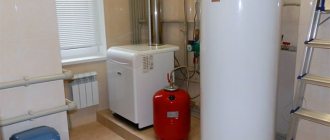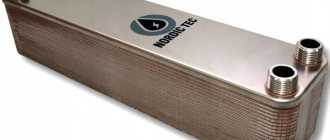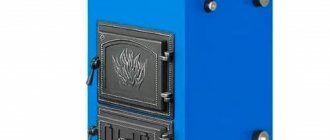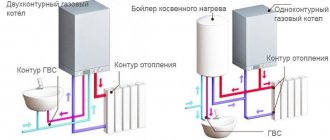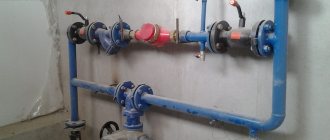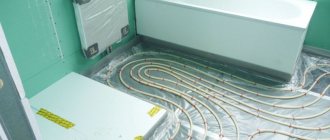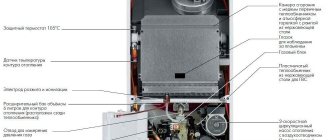Home » Heating and water supply » Gas boilers in the hot water supply system » How to choose a gas boiler for water supply?
Having decided to purchase a gas boiler, consumers often want to provide themselves not only with heating, but also with hot water. There are different options for gas boilers for water supply: double-circuit units, with a built-in boiler or with an indirect heating tank. Depending on the required volume of hot water, the best option is selected.
…
- 1 Options for gas boilers for water supply - their pros and cons 1.1 Double-circuit gas boilers
- 1.2 Units with built-in boiler
- 1.3 Indirect heating boiler
The principle of operation of a boiler with two circuits
From the name it is clear that such a device has all two circuits. The first circuit is intended for heating. The second is to provide hot water. The operating principle of a double-circuit boiler is simple. The default is to use the first circuit. No heat enters the second circuit. A special valve is used for this. When the hot water turns on, the valve prevents heat from entering the heating system. Instead, it enters the second circuit and heats the water. When the water turns off, only the heating works again. That is, hot water is used on demand and the rest of the time there is no excess gas consumption
Types of double-circuit boilers
There are a considerable number of options for boilers with two circuits. We have divided them into segments and will describe each in detail.
By heating method
- Flow-through. Such models are very popular. They are very powerful and allow hot water to flow into the faucet quickly. In such boilers, either two separate heat exchangers are used (one is used to heat the coolant, and the other is used to transfer heat from the heated coolant of the heating system to the hot water supply circuit), or one bithermic (one heat exchanger heats the coolant of the heating system and hot water).
- With built-in tank. Less common. With this design, the water is first heated in a separate tank and only then enters the mixer. Often, such boiler models are purchased quite rarely. Many people prefer to install a separate boiler and indirect heating tank. But such boiler options are quite possible. As an example, you can look at the Baxi Luna 3 Combi boiler.
By installation method
- Wall-mounted. They are extremely convenient, as they can be installed in any room, be it a corridor or a kitchen. At a fairly low price, these models have good performance. On average, they can provide heat to rooms up to 350 square meters in size. Such models are readily installed both in private houses and in apartments.
- Floor-standing. These boilers are more expensive, but they have high power and are capable of heating a huge cottage with several floors. They take up a lot of space, require a separate room and special care. Often, high-power boilers are all single-circuit, which initially means using a separate tank that will be heated by the boiler.
By method of removing liquid
- With open camera. The chamber receives oxygen from the living space. This is not always possible. The disadvantage of this solution is often the lower efficiency of the boiler. Especially if the chimney is mounted “from the bulldozer”.
- With a closed camera. Air from outside is used. They have high power and excellent tightness. They do not require a full chimney. They are usually equipped with a meter-long coaxial pipe, which is sufficient for normal operation of the boiler.
What is the price
The first principle of dividing gas boilers in terms of cost is the difference in the control system. Mechanical non-volatile control will cost less and even last longer. However, with electronic control, the calculation is for maximum comfort, and the durability of a high-quality boiler is still calculated in decades.
The second principle is the localization of boiler production. Foreign boilers are sometimes an order of magnitude more expensive than their domestic counterparts; in addition, among imported models there is rarely the simplest version of a gas boiler; almost all offers have wide functionality with a correspondingly high cost.
| Manufacturer | Model | power, kWt | Installation | DHW | The combustion chamber | Price, rub |
| Ariston | Egis Plus 24 CF | 25,8 | Wall | Yes | open | 38 500 |
| Unobloc GPV 24 RI MET | 24,0 | Floor | No | open | 85 000 | |
| Clas EVO 24 FF | 24,0 | Wall | Yes | closed | 48 600 | |
| Buderus | Logamax U072 - 24 | 24,0 | Wall | No | closed | 44 500 |
| Logamax U052-24 K | 24,0 | Wall | Yes | closed | 51 000 | |
| Logamax plus GB072 24 K | 24,0 | Wall | Yes | closed | 88 500 | |
| Viessmann | Vitopend 100-W WH1D268 | 24,0 | Wall | Yes | open | 47 600 |
| Vitopend 100-W WH1D274 | 24,8 | Wall | No | closed | 47 900 | |
| Vitogas 100-F GS1D870 | 29,0 | Floor | No | open | 140 000 | |
| Borinskoe | AOGV-23.2-1 Eurosit | 23,2 | Floor | No | open | 15 700 |
| AKGV-23.2-1 Eurosit | 23,2 | Floor | Yes | open | 17 800 | |
| Zhukovsky | AOGV-23.2-3 ZHUK (01), square | 23,2 | Floor | No | open | 21 600 |
| AKGV-23.2-3 Comfort | 23,2 | Floor | Yes | open | 22 200 | |
| AKGV-23.2-3 ZHUK (01), square | 23,2 | Floor | Yes | open | 25 600 |
Types of heat exchangers in boilers
gas boiler heat exchanger
With the help of a heat exchanger, heat is transferred from the combustible gases to the coolant and to water. There are actually several of them:
- Bithermic. It is a “pipe-in-pipe” device. The outer one is intended for heating, and the inner one is for heating water. Boilers with similar heat exchangers are inexpensive but reliable. However, the volume of heated water is not large. We have already written above about the principle of operation of a bithermal heat exchanger in a double-circuit boiler.
- Monothermic. For heating and water heating, two heat exchangers are used. The large one heats the water, which provides heating and heats the small one, into which cold water flows and heats up. This is the most common option for a double-circuit boiler heat exchanger in a private house or apartment.
- Steel. The most common type, since steel is the cheapest material for its production. It has low durability - it will last 15 years, and if the steel is of low quality, then no more than 5. But such devices have high mechanical strength. They are also not afraid of sudden temperature changes.
- Cast iron. The most durable. But at the same time it is very heavy and fragile. Well, for the price it likes to bite.
- Copper. It is often used in all wall-mounted boilers with one or two circuits.
Rating of the TOP 12 best floor-standing gas boilers of 2020-2021
This rating includes the best floor-standing gas boilers for heating according to experts and ordinary users.
- Place
- Name
| TOP 3 best floor-standing gas boilers in price-quality ratio | ||
| 1 | Lemax Premium-30B 30 kW | |
| 2 | Lemax Premium-30N 30 kW | |
| 3 | BAXI SLIM 1.150 i 14.9 kW | |
| TOP 3 best floor-standing single-circuit gas boilers | ||
| 1 | Lemax Leader-25N 25 kW | |
| 2 | Lemax Wise 25 25 kW | |
| 3 | Lemax Premium-20 20 kW | |
| TOP 3 best floor-standing double-circuit gas boilers | ||
| 1 | ATON Atmo 10ЕВМ 10 kW | |
| 2 | Protherm Bear 30 KLZ 26 kW | |
| 3 | Lemax Premium-20B 20 kW | |
| TOP 3 best floor-standing energy-independent gas boilers | ||
| 1 | Lemax Patriot-10 10 kW | |
| 2 | Lemax Premium-16 16 kW | |
| 3 | Siberia 17 17.4 kW | |
Minimum characteristics of double-circuit boilers
When choosing a boiler for your home, you need to consider the following parameters:
- Power. Shows how much heat is being produced.
- Efficiency Efficiency of using heat from the flame. Characterizes how economical the boiler is.
- Temperature of the gases released.
- Where heat is conducted. Water or antifreeze.
- Maximum pressure for work.
- Outlet temperature maximum
- Hot water capacity. How much water heats up in one minute. Depends on the desired water temperature.
- Maximum amount of gas required.
- Gas supply. Characterizes stability of operation during sudden jumps.
- Features of electricity consumption: voltage and frequency.
- The power that is expended.
- Dimensions, including weight, fastening features and gas exhaust dimensions. These features do not indicate whether the boiler is good or bad. They must correspond to the purposes of operation. For example, boilers with different capacities are suitable for heating rooms of different sizes.
But in reality, you will get tired of paying attention to all these characteristics. Just remember that wall-mounted boilers are basically all the same in these characteristics. They differ simply in small details. With floor-mounted ones, of course, more attention is required.
Models and cost
Single-circuit wall-mounted boilers are offered by the following manufacturers: Vaillant; Baxi; Ariston; Bosch; BERETTA, NOVA
Vaillant
Popular models:
- BERETTA CITY 28 RSI (turbo). Average cost: $510;
- Bosch WBN 6000-24H RN. Average cost: $580;
- Ariston CLAS EVO SYSTEM 24 FF. Average cost: $490;
- NOVA FLORIDA PICTOR DUAL LINE RTFS 28. Average cost – $630.
The choice of a specific product depends on the area of the room, functionality and performance characteristics.
Double-circuit wall-mounted boilers are offered by the following companies: Ferroli, Ariston, BERETTA, Chaffoteaux and others.
Popular models:
- Chaffoteaux ALIXIA S 18 FF. Average cost: $400;
- Ariston MATIS 24 FF. Average cost: $410;
- Ferroli Domina F24. Average cost: $380;
- BERETTA CIAO 24 CSI (turbo). The average cost is $420.
These devices mostly have the same power. The equipment differs in performance characteristics, efficiency, and functionality.
Floor equipment
Double-circuit floor-standing gas boiler
It is installed mainly in a separate room. The heat exchanger of the device can be made of high-quality steel or cast iron. Both materials have their pros and cons.
The cast iron heat exchanger is not susceptible to moisture. It is less susceptible to corrosion. Cast iron is a brittle material. This increases the risk of damage to the heat exchanger when transporting equipment, as well as loading and unloading it. In addition, the destruction of cast iron products occurs due to the use of too hard water in the system.
A heat exchanger made of steel has less weight than a cast iron one; the metal is not susceptible to damage during transportation. Failure to comply with the operating rules of the equipment leads to metal corrosion and subsequent failure of the heat exchanger.
Models made of copper and stainless steel are less common. Both varieties are not subject to corrosion and are not afraid of mechanical damage. The cost of metal is significantly higher, which affects the price of the heat exchanger and boiler itself.
You can minimize the risk of breakdown of a steel floor-standing boiler and extend its service life by carefully ensuring that the temperature in the system does not fall below the so-called dew point. In this case, condensation does not form on the surface, which has a destructive effect on the metal.
Types of burners of floor-standing boilers
Types of burners of floor-standing boilers
Floor-standing equipment may have an atmospheric or inflatable burner. Each of them has its own characteristics. An inflatable burner has a high cost and at the same time high efficiency. Atmospheric burners are much quieter and less expensive. In addition, the atmospheric burner is included in the cost of the main equipment, being its integral part.
An inflatable burner is purchased additionally. It is not included with the boiler. Equipment with an atmospheric burner has a power of 10-80 kW. Boilers with inflatable burners can have a power of several thousand kilowatts. This allows the device to be used for heating very large areas.
The heat exchanger of a floor-standing boiler is afraid of the formation of scale resulting from the deposition of mineral compounds.
Floor-standing boiler heat exchanger
Scale interferes with normal heat exchange, which, in turn, reduces equipment productivity and also leads to excessive gas consumption.
Boiler power calculation
Like any boiler, a double-circuit boiler must be selected taking into account the required power. You need to select it wisely based on the heat loss of your home, which you can’t always calculate on your own. The roughest approach is to provide 1 kW of power per 10 square meters of your home.
But it's another matter if you are going to use the second circuit on an ongoing basis. Based on the boiler power, the amount of hot water released per minute depends. Everything is simpler here. You need a minimum of 24 kW of power to be sure that you will have enough hot water production. Typically, a boiler of this power is capable of releasing 12-14 liters of water per minute. This volume is just enough to take a shower or completely wash the dishes.
Advantages
Gas boilers are one of the most common; the equipment has a number of advantages in comparison with electric and solid fuel boilers:
- Depending on the power, the equipment allows you to heat both a very small room and a country house of impressive size;
- Gas boilers have a high efficiency. A number of models have an efficiency of up to 98%;
- The cost of gas for equipment is much lower than the price of electricity and solid fuel;
- The device delivers much more energy than it consumes;
- There is no need to watch the flame during installation. Gas is supplied to the device continuously. The owner will not have to get up at night to add fuel to the boiler;
- If for some reason the flame in the equipment goes out, the built-in sensor independently notifies the electric ignition system, resulting in a spark being supplied to the burner;
- The equipment is easy to use. Start-up and shutdown are carried out using one button.
- Gas boiler equipment has a long service life. If the rules of use are followed, it can serve for decades without losing its performance and characteristics.
The required temperature is set and adjusted manually or using weather-dependent automation;
Flaws
Like any other equipment, gas boilers have their drawbacks. These include:
- To install the equipment, you will have to meet certain conditions that relate to the technical side. Relevant documents must be completed. The installation is approved by Gaztekhnadzor. To sign the documents, a project must be provided, a copy of the agreement with the organization carrying out the installation, a copy of the license of this company to carry out activities for the installation of gas equipment;
- Before installation, you should install a chimney, the main function of which is to remove waste substances. If there is a fireplace or a second boiler in the house that runs on a different fuel, a separate chimney is provided for gas equipment. Connecting it to a common one is strictly prohibited. A spark from a boiler in a common chimney can lead to a fire or explosion;
- Installation of a floor-standing boiler is carried out only in a well-ventilated room with a separate exit to the street and an opening window or vent. This is important for equipment with an atmospheric burner;
- At low pressure in the gas pipeline system, the boiler may begin to smoke, and its efficiency decreases. The same applies to burner wear. Over time, it also begins to smoke;
- When installing a device for heating a room with an area of less than 100 m2, it is necessary to install an automatic system that monitors gas leaks. Therefore, for small buildings, installation of gas boiler equipment may not be economically viable.
Two circuits or a separate boiler?
The most intriguing question is: in what cases is it worth using a double-circuit boiler for hot water, and in what cases is it better to install a separate tank.
If, for example, you have an apartment with its own heating, but only one bathroom, then you can quite easily use a boiler with two circuits. The same applies to private houses. In this case, there will be plenty of hot water.
If you have a substantial house for a large family, 2-3 bathrooms, then in this case it is better to use an indirect heating boiler in conjunction with a single-circuit boiler. The same applies to public facilities.
So, we looked at the features and main characteristics of double-circuit boilers. We hope that the information presented will help you decide on the choice of device for your home. Remember that a properly selected unit will be able to keep you warm and provide hot water. May your home always have good weather, warmth, food and hot water!

